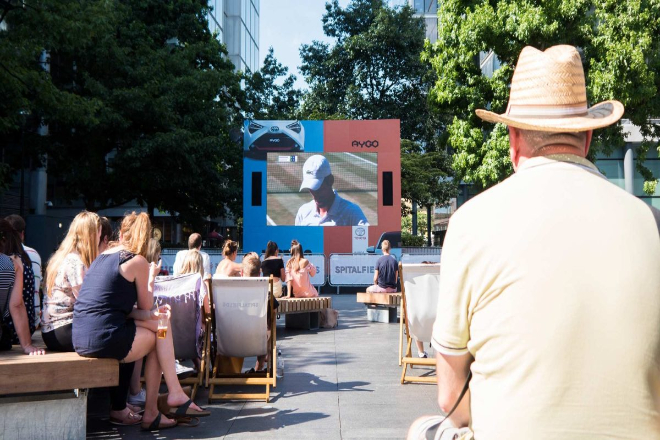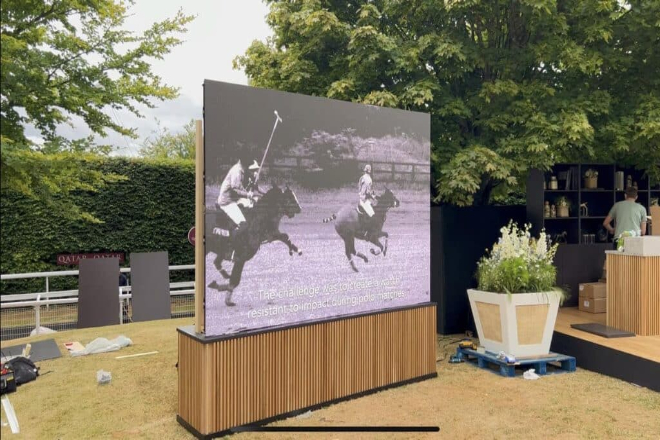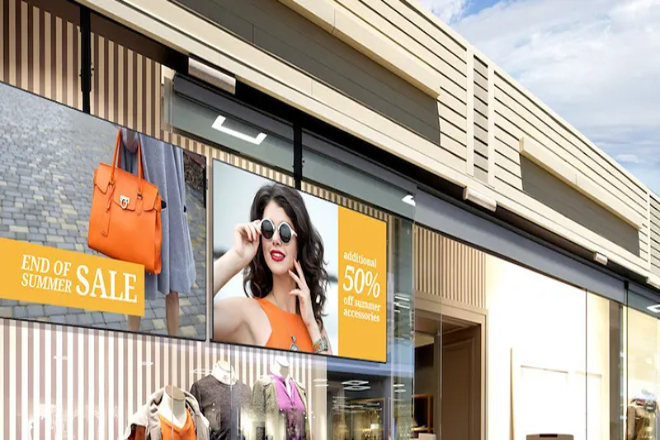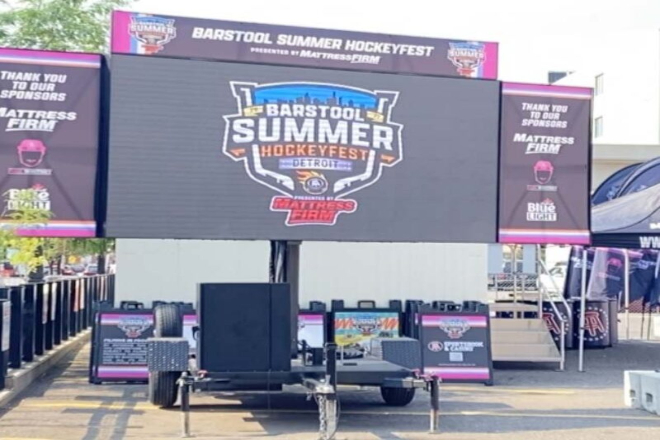Introduction

Every summer, not only do people feel hot, but Afficheurs LED also begin to “be unable to bear it.”
You may not have noticed that those shiny screens are actually experiencing an invisible high-temperature “test.”
Want to know how they survive the hot summer? This article will show you how to protect these “hard-working” LED displays in hot weather.
Table des matières
1. Understand the impact of high temperatures in summer on LED displays
The impact of high temperatures in summer on LED displays is not small, so we have to talk about it.
In the hot summer, components such as chips and circuits of LED displays are prone to “getting angry” and various problems.
Let’s talk about chips first. Chips are the core components of LED displays, just as important as the human heart.
But when high temperatures come, chips are prone to “fever.” When the temperature is too high, the luminous efficiency of the chip will plummet, and the light decay will also accelerate.
Just like a light bulb will become dimmer after a long time, the LED display will become less bright. Moreover, high temperatures will make the chip age faster, and there will be more and more defects inside, just like wrinkles on human skin.
The chip will become “worn out.” Worse, if the temperature is too high, the chip may break directly, and the LED display will completely “strike.”
Let’s look at the circuit again. The circuit is like the “blood vessels” of the LED display, responsible for transmitting current and signals.
High temperatures will accelerate the aging of materials in the circuit, especially the packaging materials, which may become fragile or even crack.
Just like plastic will become brittle after being exposed to the sun for a long time, the packaging materials of the circuit will also be damaged by high temperatures, causing the LED display to malfunction.
Moreover, the phosphor will also “strike” at high temperatures, and its performance will decrease, which will greatly reduce the light efficiency of the LED display.
What’s more serious is that high temperature may cause the materials in the circuit to delaminate, just like the skin of the wall falling off, which will cause poor current transmission and even make the LED display directly scrapped.
Therefore, the impact of high temperatures in summer on LED displays is all-round; from chips to circuits, every component may be affected. If not properly protected, the LED display may have abnormal display, reduced luminosité, or even direct damage.
Method 1: Maintain good ventilation and heat dissipation
The summer heat is unbearable, and the same is true for LED displays. If you get “heatstroke” from the heat, it will be troublesome.
Therefore, you must let it “breathe” and dissipate the excess heat. This is not a trivial matter.
If the heat dissipation is not done well, the display screen is prone to problems, such as poor display effect, reduced brightness, or even direct damage. Therefore, we must learn how to dissipate heat for it.
1). Check whether the vents are unobstructed
The vents of the display screen are like its “small windows.” If they are blocked, the heat cannot be dissipated. The vents are usually on the side or back of the display screen.
You have to take a close look to see if they are blocked by dust or other things.
2). Clean the dust and debris in the vents:
You can use a small soft-bristled brush to gently sweep away the dust. If there is too much dust, you can also use the hose of the vacuum cleaner to suck it, but be sure not to touch the small parts inside the display screen.
After cleaning, make sure the vents can “breathe” smoothly so that the air can take away the heat. Don’t underestimate this step.
If the vents are blocked, the display will be like being covered in a quilt; the temperature will get higher and higher, and it may eventually break.
3). Reasonably reserve space for heat dissipation
When installing the display, be sure to leave enough space for it, and don’t squeeze it tightly; otherwise, the heat will not dissipate.
3.1). Avoid the display from being squeezed or blocked:
When installing, leave at least 10 cm of space behind and on the sides of the display so that air can circulate and take away the heat.
If the back or sides are blocked by something else, the display will be like an “ant on a hot pot.”
The temperature will get higher and higher, and it may eventually break. Moreover, don’t think that the display is fine after it is installed.
Sometimes, debris or decorations may accidentally block the vents, so check regularly to see if anything is blocking them.
Practical tips
3.2). Regular inspection:
Don’t wait until the display breaks before thinking about the heat dissipation problem. It is best to check the vents every month to see if there is dust or debris blocking them.
By the way, you can also check the environment around the display to see if there is anything blocking the heat dissipation space.
3.3). Pay attention to the ambient temperature:
If the display is placed in a place that is already very hot, such as a place under direct sunlight or near a heat source, it will be more difficult to dissipate heat.
Try to place the display in a relatively low temperature and well-ventilated place so that it can work more comfortably.
2.4). Use auxiliary heat dissipation equipment:
If conditions permit, you can put a small fan near the display to help air circulation and take away more heat. However, be careful not to put the fan too close to the display, otherwise dust may be
blown in.
In short, let the display “breathe” and don’t let it get “heatstroke” from the heat so that it can work better and last longer. Don’t underestimate these details. If you do it well, the life of the display can be extended a lot!
Method 2: Control the use time and brightness of the display

Although the LED display looks powerful, it is actually very “delicate”, especially in the summer when it is hot. If it is used for a long time and at a high intensity, it is easy to be “tired.”
Therefore, we have to learn to control the duration and brightness of the display screen so that it can be used longer and save some electricity.
Using a display screen at high brightness for a long time is like keeping a light bulb on all the time, and the brightness is adjusted to the highest.
The light bulb will definitely break soon. The same is true for LED displays. If you keep it running at high brightness, the components inside will age faster, just like people who stay up all night.
The body will definitely not be able to bear it. Moreover, high-brightness operation will generate more heat. If this heat cannot be dissipated, the display screen will “fever” and may eventually break down.
So what should we do?
In fact, it is very simple. Just adjust it according to actual needs. Controlling the duration of use is a good idea. If the display screen does not have to run 24 hours a day, don’t keep it on all the time.
For example, when there are few people at night, or the store is closed, you can turn off the display screen. This will not only extend the life of the display screen but also save a lot of electricity bills.
Adjusting the brightness is also very important. The brightness does not need to be adjusted to the highest level all the time.
Generally speaking, when the light is strong during the day, you can adjust the brightness a little higher, but don’t adjust it to the limit.
At night, when the light becomes dim, adjust the brightness a little lower. This can not only ensure the display effect but also reduce heat generation and extend the service life.
In summer, the temperature is high, and the display is more likely to “heatstroke.” At this time, it is particularly important to appropriately reduce the brightness of the display.
Lowering the brightness can reduce the heat generation of the internal components of the display, make the display “cooler,” and reduce failures caused by high temperatures.
Moreover, after the brightness is reduced, the power consumption of the display will also be reduced, which can save a lot of electricity. Don’t underestimate this point. In the long run, you can save a lot of electricity bills.
In short, controlling the use time and brightness of the display can not only extend its service life, but also save electricity, killing two birds with one stone.
Don’t let the display screen work “overloaded” all the time, use it reasonably, and it can serve you better!
Method 3: Check the power system regularly
The power system is as important to the LED display as the heart. If the power supply is unstable, the display will malfunction and be easily damaged by overheating.
Therefore, regularly checking the power system to ensure a stable and reliable power supply is a key step in protecting the display.
First, check whether the power line is aging. Aging power cords not only increase resistance and cause voltage drop, but may also cause short circuits due to damage to the insulation layer, which is very dangerous.
You can carefully check the appearance of the power cord to see if there are any damage, cracks or discoloration. If there are, it means that the line may have aged and needs to be replaced in time.
Second, check whether the power line is in good contact. Poor contact can cause unstable voltage and generate additional heat.
You can check whether the power plug and socket are plugged in tightly and whether there are signs of looseness or heat at the connection.
If you find that the plug is not plugged in tightly or there are signs of burning at the connection, you should consider replacing the plug or socket.
In addition to checking the circuit, it is also important to regularly maintain the power supply equipment.
For example, dust must be cleaned on the source de courant equipment because dust accumulation will affect heat dissipation and cause the equipment to overheat.
You can use a soft brush to gently clean the surface and heat dissipation holes of the power supply device to keep the device clean and in a good heat dissipation state.
If you find that the power supply device has abnormal sounds or odors, it may be that there is a problem inside the device. At this time, it is best to find a professional maintenance personnel to check.
In short, regularly check the power supply system to ensure that the power supply is stable and reliable, which can not only prevent the LED display from overheating and damage, but also extend the service life of the display.
Don’t underestimate these details. If you do it well, the display can run more stably.
Method 4: Avoid direct sunlight

When installing LED displays outdoors, direct sunlight is a problem that needs special attention.
Direct sunlight will cause the surface temperature of the display to rise sharply, just like exposing the display to the sun, which will cause the heat inside the display to accumulate faster, thereby affecting its performance and life.
In order to avoid direct sunlight, some sunshade measures can be taken. For example, install a sunshade above the LED display, or use a sunshade cloth.
The sunshade can not only block the sun, but also prevent rain from eroding the display. The sunshade cloth is more flexible and can adjust the range of shading as needed.
These measures can effectively reduce the impact of direct sunlight on the display screen, allowing the display screen to work in a more comfortable environment.
When installing the LED display screen, it is also important to choose the installation location reasonably.
Try to avoid installing the display screen in a place where the sun shines directly for a long time.
For example, do not install the display screen on the south-facing wall because it has the longest direct sunlight.
If there is really no way to avoid direct sunlight, try to choose a sheltered place or set up some shelters around the display screen, such as trees or shadow areas of buildings.
In short, avoiding direct sunlight can not only reduce the surface temperature of the display screen and reduce heat accumulation, but also extend the service life of the display screen.
When installing the display screen outdoors, be sure to consider these factors so that the display screen can work in a better environment.
Method 5: Take waterproof and moisture-proof measures
Although it is hot in summer, thunderstorms are also prone in many places.
If the LED display screen is wet by rain or stays in a humid environment for a long time, it is easy to be damaged by moisture.
Therefore, waterproof and moisture-proof measures must be taken.
First, check the waterproof sealing performance of the LED display screen. The sealing strip of the display screen shell is particularly important. It is like a line of defense that prevents rain and moisture from entering the interior of the display screen.
You can carefully check whether the sealing strip is aged, cracked or damaged. If you find that the strip is aged or damaged, you should replace or repair it in time.
Otherwise, once it rains, rainwater will seep in and damage the components inside the display.
In a humid environment, the sealing strip alone may not be enough. At this time, you can use dehumidification equipment or ventilation equipment to reduce the humidity of the surrounding environment.
For example, a dehumidifier can be placed near the LED display to absorb moisture in the air, which can reduce the possibility of moisture on the display. Or, install a ventilation fan to circulate air and exhaust moisture.
In this way, the display can work in a relatively dry environment and reduce the risk of moisture short circuits.
In short, waterproof and moisture-proof measures are very important, especially in summer when the weather is changeable. Doing these measures can effectively protect the LED display and allow it to work normally in all weather conditions.
Method 6: Clean the surface of the display

After the LED display has been used for a long time, it is easy to accumulate dust on the surface, especially for outdoor LED displays.
Too much dust will not only affect the heat dissipation effect of the display screen, making the display screen more likely to “fever”, but may also cause display failures on the display screen, such as blurred images or black spots.
Therefore, it is necessary to clean the surface of the display screen regularly.
When cleaning the display screen, wipe it gently with a soft, dry cloth or a special cleaning tool.
Don’t use a cloth or tool that is too hard. Otherwise, it will scratch the surface of the display screen. Don’t use detergents containing corrosive ingredients, such as alcohol or some strong acid and alkali detergents, which will damage the surface of the LED display screen.
Generally speaking, you can wipe off the dust by gently wiping it with a clean, soft cloth. If the dust is stubborn, you can slightly wet the cloth with a little clean water, but be sure to wring it dry to prevent water from dripping into the display screen.
When cleaning the display screen, safety is also very important. Make sure that the LED display screen is turned off and unplug the power plug to avoid the risk of electric shock.
Don’t underestimate this step, safety first. After cleaning, wait for the display screen to be completely dry, then plug in the power again and turn on the display screen.
In short, regular cleaning of the display surface can not only improve the heat dissipation effect, but also prevent display failures, so that the display can always be in good condition.
Method 7: Timely repair and replacement of damaged parts
When the temperature is high in summer, the LED display is easy to “gets angry” and has various minor problems. Therefore, we must pay close attention to the operation status of the display.
Once we find something wrong, such as abnormal display color, black screen phenomenon, etc., don’t delay, and contact professional maintenance personnel to check and repair it.
Sometimes, some parts of the LED display may be damaged to the point where they cannot be repaired.
At this time, don’t force it, and replace new parts in time. For example, if the cooling fan is broken, you have to replace it with a new one quickly. Otherwise, the LED display will not be able to dissipate heat, and it will easily “fever.”
For another example, if there is a problem with the power module, it must be replaced in time; otherwise, the display may not work properly.
Replacing damaged parts in time not only ensures that the display can dissipate heat and operate normally but also avoids the expansion of faults and reduces maintenance costs.
In short, if you find that there is a problem with the LED display, don’t hesitate and deal with it in time. Repair what needs to be repaired and replace what needs to be replaced, so that the display can always be in good condition.
Method 8: Make an emergency plan

The weather in summer is unpredictable, and extreme weather such as high temperature and thunderstorms can come at any time.
At this time, if you are not prepared in advance, the display screen is prone to problems. Therefore, it is very important to make an emergency plan.
For example, when a high-temperature warning is issued, some temporary heat dissipation measures can be taken.
In addition to the ventilation and heat dissipation, brightness control, and other methods mentioned above, you can also prepare some ice packs or cold towels and place them near the display screen to help them cool down.
Of course, this is only a temporary measure and cannot be relied on for a long time.
In thunderstorms, be sure to remember to cut off power protection. Thunderstorms are prone to lightning strikes.
If the LED display screen is still running, it may be damaged by lightning. Therefore, when encountering thunderstorms, it is best to turn off the power of the display screen in advance and unplug the power plug.
Wait until the weather is good before turning it on again.
It is also important to regularly rehearse emergency plans. Through rehearsals, everyone can become familiar with the steps to deal with emergencies and improve their ability to deal with them.
For example, you can simulate the heat dissipation operation during a high-temperature warning or the power outage process during a thunderstorm.
In this way, once an emergency situation really occurs, everyone can respond in an orderly manner to ensure that the display screen can operate safely and stably in summer.
In short, make emergency plans in advance and conduct regular drills so that you can be prepared and protect the display screen when facing extreme weather.
Method 9: Install air conditioner
Summer is here, the weather is getting hotter and hotter, and LED display screens are also prone to “heatstroke”. High temperature will not only affect the display effect of the screen, but also shorten the service life of the equipment.
Therefore, it is particularly important to cool down the LED display screen and let it safely pass the hot summer!
First of all, the LED display screen will generate heat when it is working. If the heat dissipation is not good, the heat will accumulate inside the device, causing the screen to overheat.
The overheated screen will not only cause problems such as screen flickering and color distortion but may also damage the circuit board and other key components. The service life of the LED display screen will be greatly shortened if it is in a high-temperature environment for a long time.
For example, a normal screen can be used for 5-10 years, but it may be scrapped in less than 3 years in a high-temperature environment. This not only wastes money but also affects the normal operation of the bar.
Installing air conditioning is the most direct and effective way to cool down. The air conditioner can adjust the indoor temperature and keep it at a relatively stable level, allowing the screen to work in a comfortable environment.
Generally speaking, the optimal operating temperature of the LED display screen is 18℃-25℃. You can set the air conditioner temperature within this range to ensure the normal operation of the screen without wasting electricity.
Of course, after installing the air conditioner, don’t forget to clean the air conditioner filter and heat dissipation holes regularly to ensure the cooling effect of the air conditioner.
If the air conditioner is broken, repair it in time to avoid letting the screen “suffer” under high temperatures.
11. Conclusion
In general, although high temperatures in summer are inevitable, through scientific and reasonable protection and maintenance measures, we can effectively extend the service life of LED display screens and ensure that they can still present information stably and clearly in hot weather. Doing every detail well is the greatest protection for the equipment.
Enfin, si vous souhaitez en savoir plus sur les écrans d'affichage LED, veuillez nous contacter.
